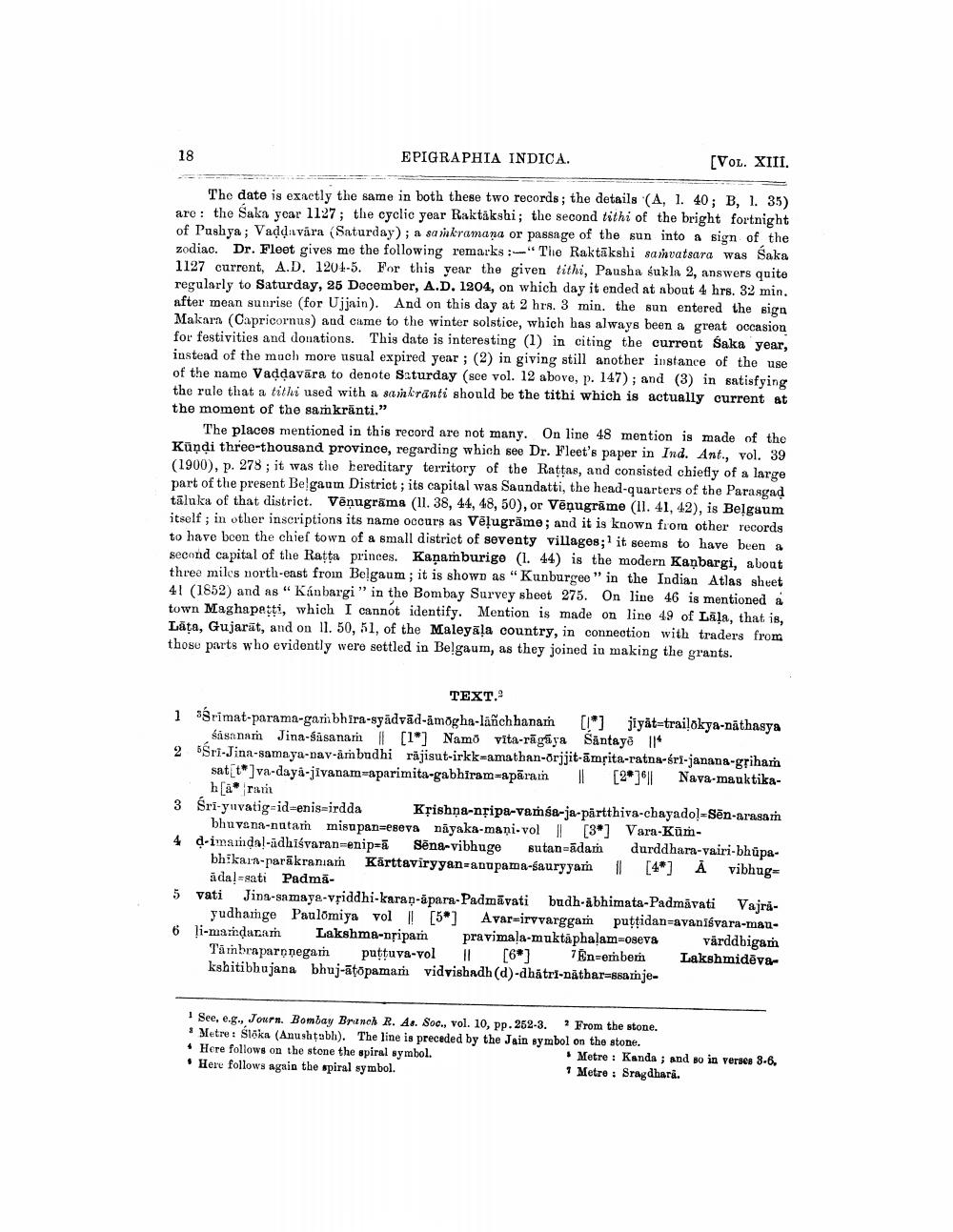________________
EPIGRAPHIA INDICA.
[VOL. XIII.
The date is exactly the same in both these two records; the details (A, 1. 40; B, 1. 35) are the Saka year 1127; the cyclic year Raktakshi; the second tithi of the bright fortnight of Pushya; Vaḍdavara (Saturday); a samkramana or passage of the sun into a sign of the zodiac. Dr. Fleet gives me the following remarks:-"The Raktakshi samvatsara was Śaka 1127 current, A.D. 1204-5. For this year the given tithi, Pausha śukla 2, answers quite regularly to Saturday, 25 December, A.D. 1204, on which day it ended at about 4 hrs. 32 min. after mean sunrise (for Ujjain). And on this day at 2 hrs. 3 min. the sun entered the sign Makara (Capricornus) and came to the winter solstice, which has always been a great occasion for festivities and donations. This date is interesting (1) in citing the current Saka year, instead of the much more usual expired year; (2) in giving still another instance of the use of the name Vaḍḍavāra to denote Saturday (see vol. 12 above, p. 147); and (3) in satisfying the rule that a tithi used with a sankranti should be the tithi which is actually current at the moment of the samkranti."
18
The places mentioned in this record are not many. On line 48 mention is made of the Kündi three-thousand province, regarding which see Dr. Fleet's paper in Ind. Ant., vol. 39 (1900), p. 278; it was the hereditary territory of the Raṭṭas, and consisted chiefly of a large part of the present Belgaum District; its capital was Saundatti, the head-quarters of the Parasgad taluka of that district. Vēnugrama (11. 38, 44, 48, 50), or Vēnugrame (11. 41, 42), is Belgaum itself; in other inscriptions its name occurs as Vēļugrame; and it is known from other records. to have been the chief town of a small district of seventy villages; it seems to have been a second capital of the Ratta princes. Kanamburige (1. 44) is the modern Kanbargi, about three miles north-east from Belgaum; it is shown as "Kunburgee" in the Indian Atlas sheet 41 (1852) and as "Kánbargi" in the Bombay Survey sheet 275. On line 46 is mentioned a town Maghapatti, which I cannot identify. Mention is made on line 49 of Lala, that is, Läṭa, Gujarat, and on 11. 50, 51, of the Maleyala country, in connection with traders from those parts who evidently were settled in Belgaum, as they joined in making the grants.
TEXT.
1
rimat-parama-garbhira-sydvd-âmögha-läñchhanah
[*]-trailskya-näthasya
sasanam Jina-sasanam [1] Namo vita-ragaya Santaye ||* 2 Sri-Jina-samaya-nav-ambudhi räjisut-irkk-amathan-orjjit-amrita-ratna-éri-janana-griham [2]|| Nava-mauktika
sattva-days-jivanam-aparimita-gabhiram-apām
||
h[a ram
3 Śri-yuvatig-id-enis-irdda Krishna-nṛipa-vamsa-ja-partthiva-chayadol-Sen-arasam bhuvana-nutam misupan=eseva nayaka-mani-vol || [3] Vara-Kum4 d-imamdal-adhiśvaran=enip=a Sēna-vibhuge sutan adam durddhara-vairi-bhupabhikara-parakraniam Karttaviryyan-anupama-sauryyam || [4] A vibhug= adal-sati Padma
5 vati Jina-samaya-vriddhi-karan-apara-Padmavati budh-abhimata-Padmavati Vajrāyudhamge Paulomiya vol [5] Avar-irvvarggam puṭṭidan-avanisvara-mau6 li-mamdanam Lakshma-nripam pravimala-muktaphalam-ova värddbigam Tambraparṇnegam puṭṭuva-vol [6] 7En-ember Lakshmidevakshitibhujana bhuj-aṭopamam vidvishadh (d)-dhatri-nathar-ssamje
||
1 See, e.g., Journ. Bombay Branch R. As. Soc., vol. 10, pp. 252-3. 2 From the stone. Metre: Śloka (Anushṭabh). The line is preceded by the Jain symbol on the stone.
Here follows on the stone the spiral symbol. Here follows again the spiral symbol.
Metre Kanda; and so in verses 3-6. 7 Metre Sragdhara.




